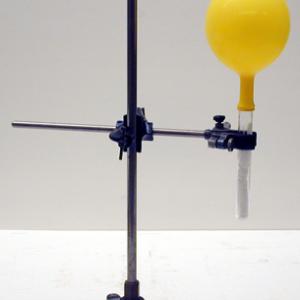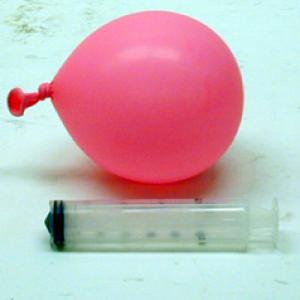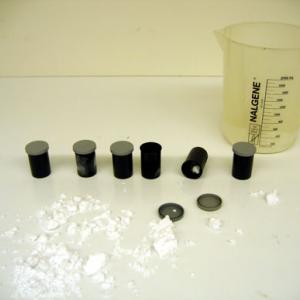College of Liberal Arts & Sciences
4C40.15 - Change of Volume with Change of State - CO2 or Liq. N2 and a Balloon
Video Credit: Jonathan M. Sullivan-Wood.
Fill the test tube with dry ice. Place the balloon over the end of the tube. As the dry ice warms it will change to a gas and expand the balloon. The balloon can be made to blow off the tube if heat is applied to the test tube rapidly enough. An alternative is to inject the CO2 into the balloon with the modified syringe. Insert the syringe far into the neck of the balloon to make this work effectively.
Liquid Nitrogen can be substituted for the CO2 as it expands about 1000 times when going from liquid to gas. Realize that this is different from the CO2 as the CO2 is going from a solid to a gas, whereas the liquid nitrogen is only going from liquid to a gas. You may speed up the expansion process by placing the balloons into a pan of warm water.
You can make a small explosion by putting CO2 into a film canister and then setting it top down on the table. When the pressure builds sufficiently, the canister will "pop", shooting the body of the canister into the air.
- J. Thomas Dickinson, "Liquid Nitrogen in a Balloon", TPT, Vol. 15, # 6, Sept. 1977, p. 361.
- Hk - 1: Freier and Anderson, A Demonstration Handbook for Physics.
Disclaimer: These demonstrations are provided only for illustrative use by persons affiliated with The University of Iowa and only under the direction of a trained instructor or physicist. The University of Iowa is not responsible for demonstrations performed by those using their own equipment or who choose to use this reference material for their own purpose. The demonstrations included here are within the public domain and can be found in materials contained in libraries, bookstores, and through electronic sources. Performing all or any portion of any of these demonstrations, with or without revisions not depicted here entails inherent risks. These risks include, without limitation, bodily injury (and possibly death), including risks to health that may be temporary or permanent and that may exacerbate a pre-existing medical condition; and property loss or damage. Anyone performing any part of these demonstrations, even with revisions, knowingly and voluntarily assumes all risks associated with them.



